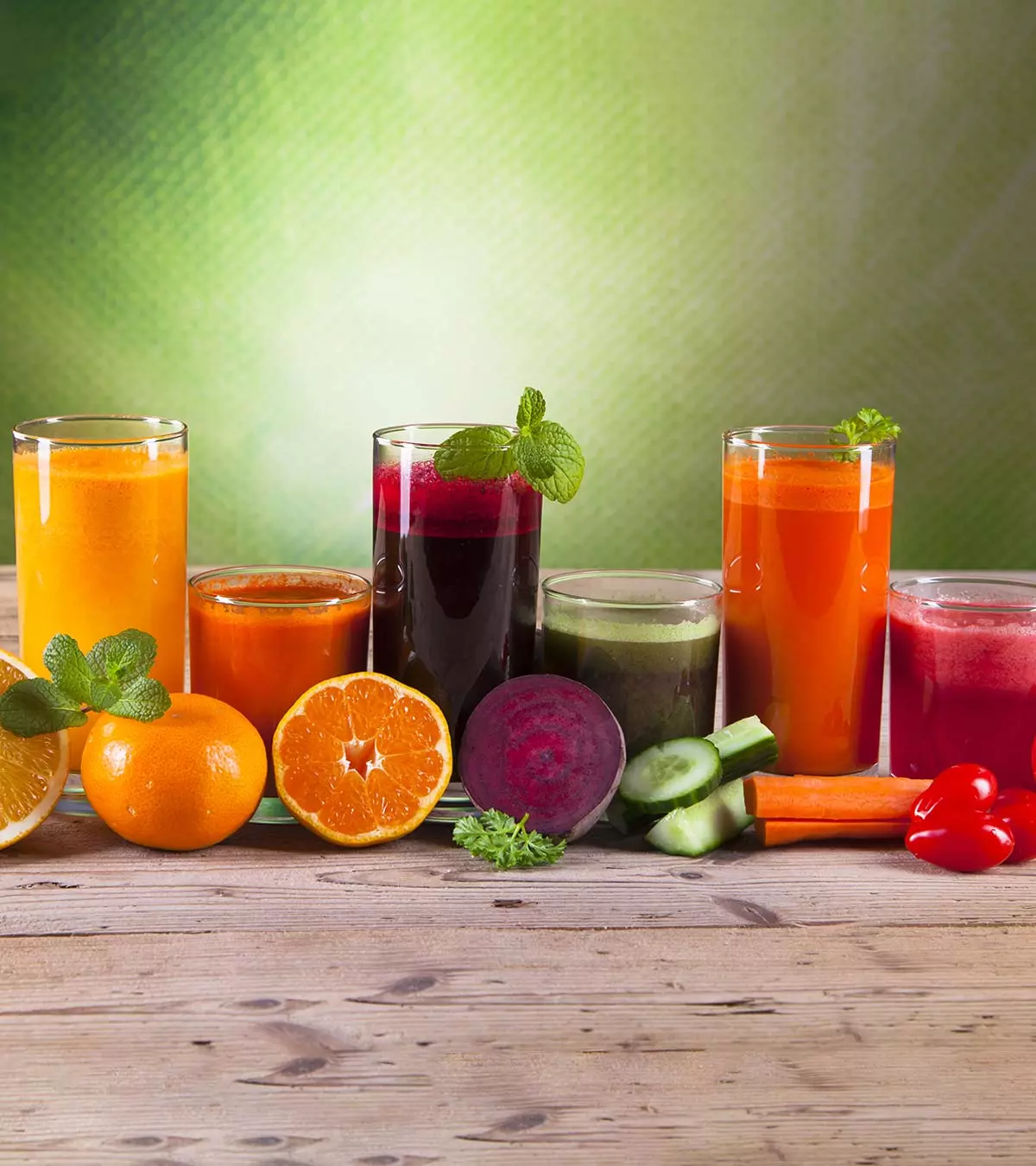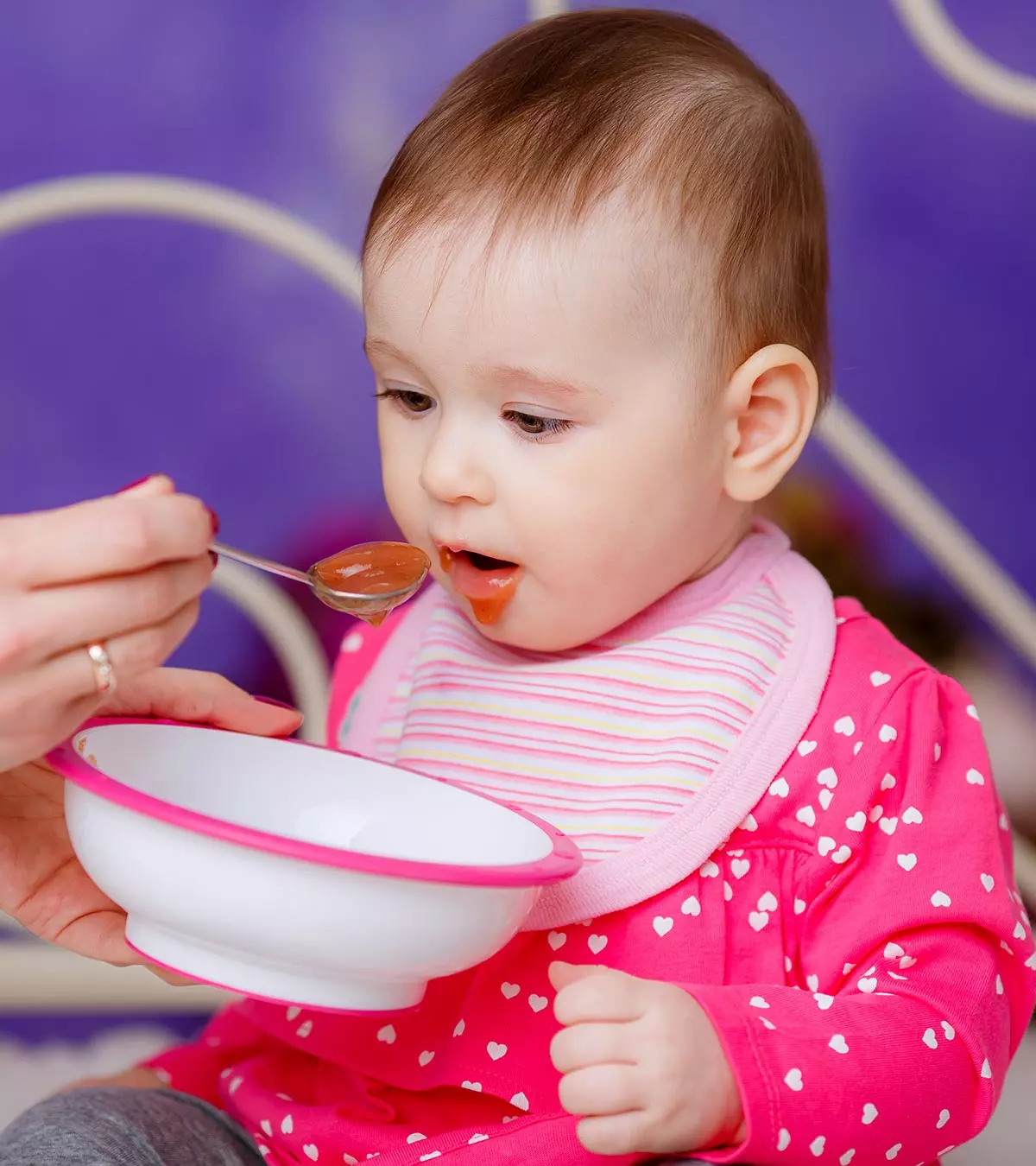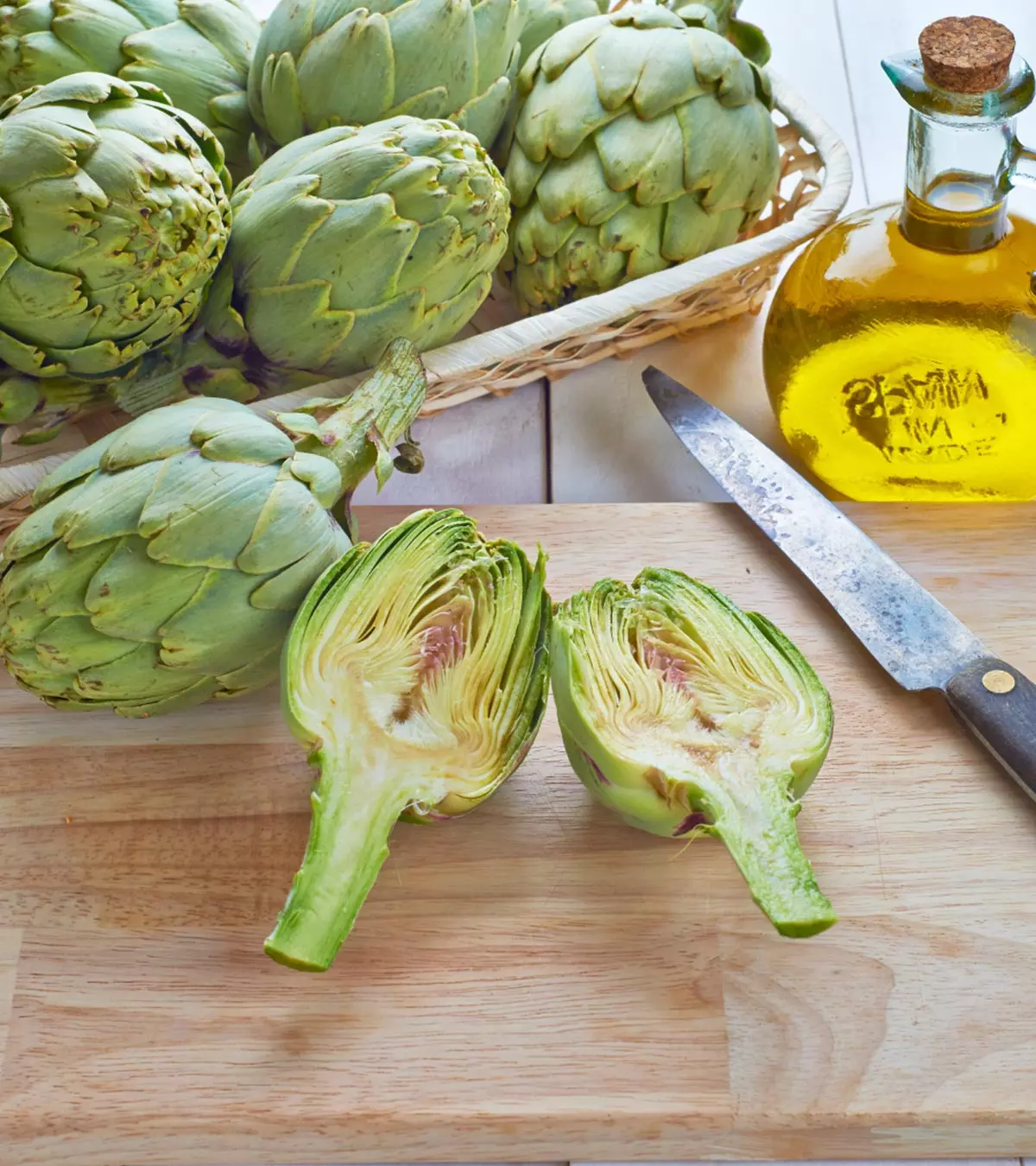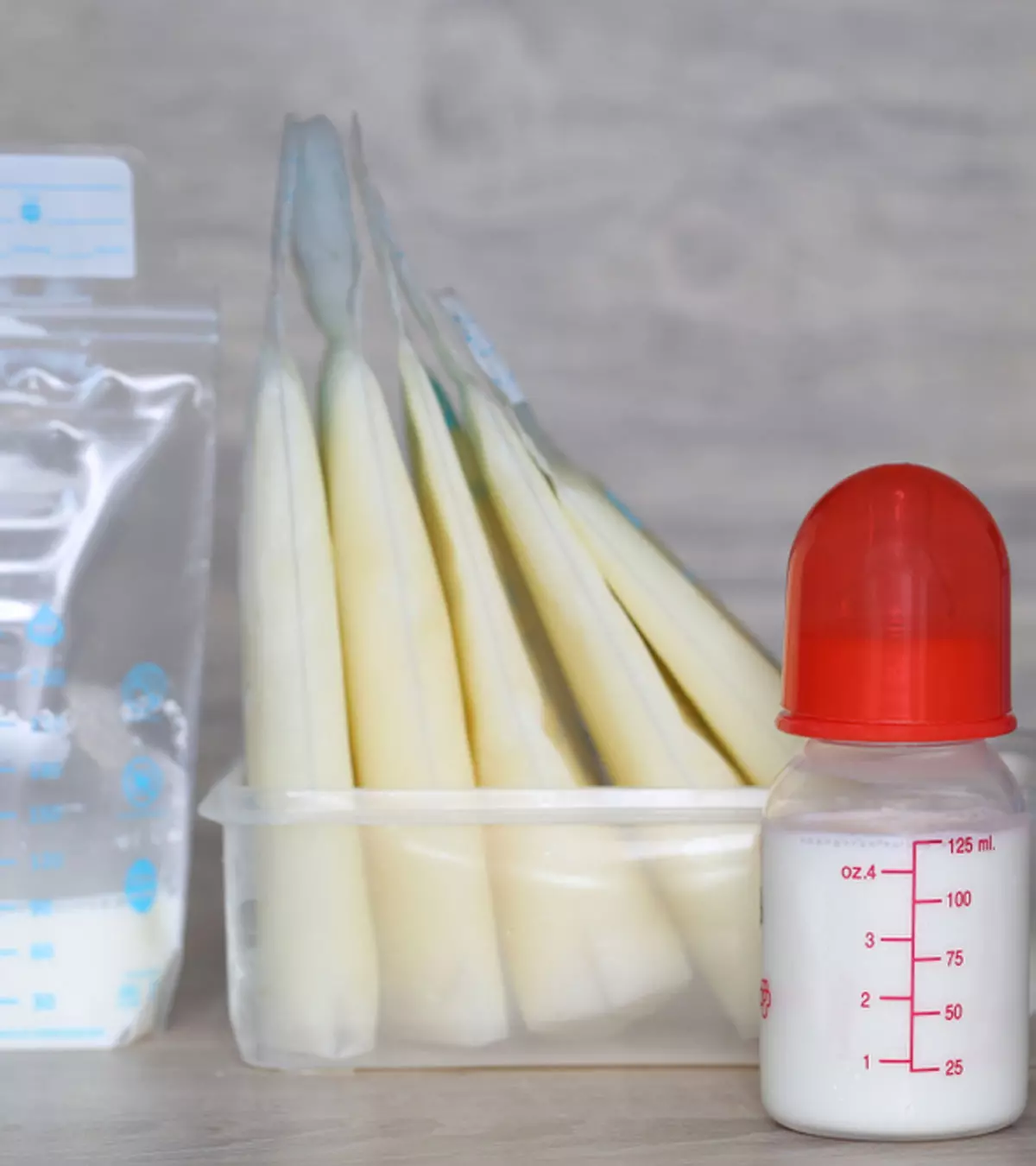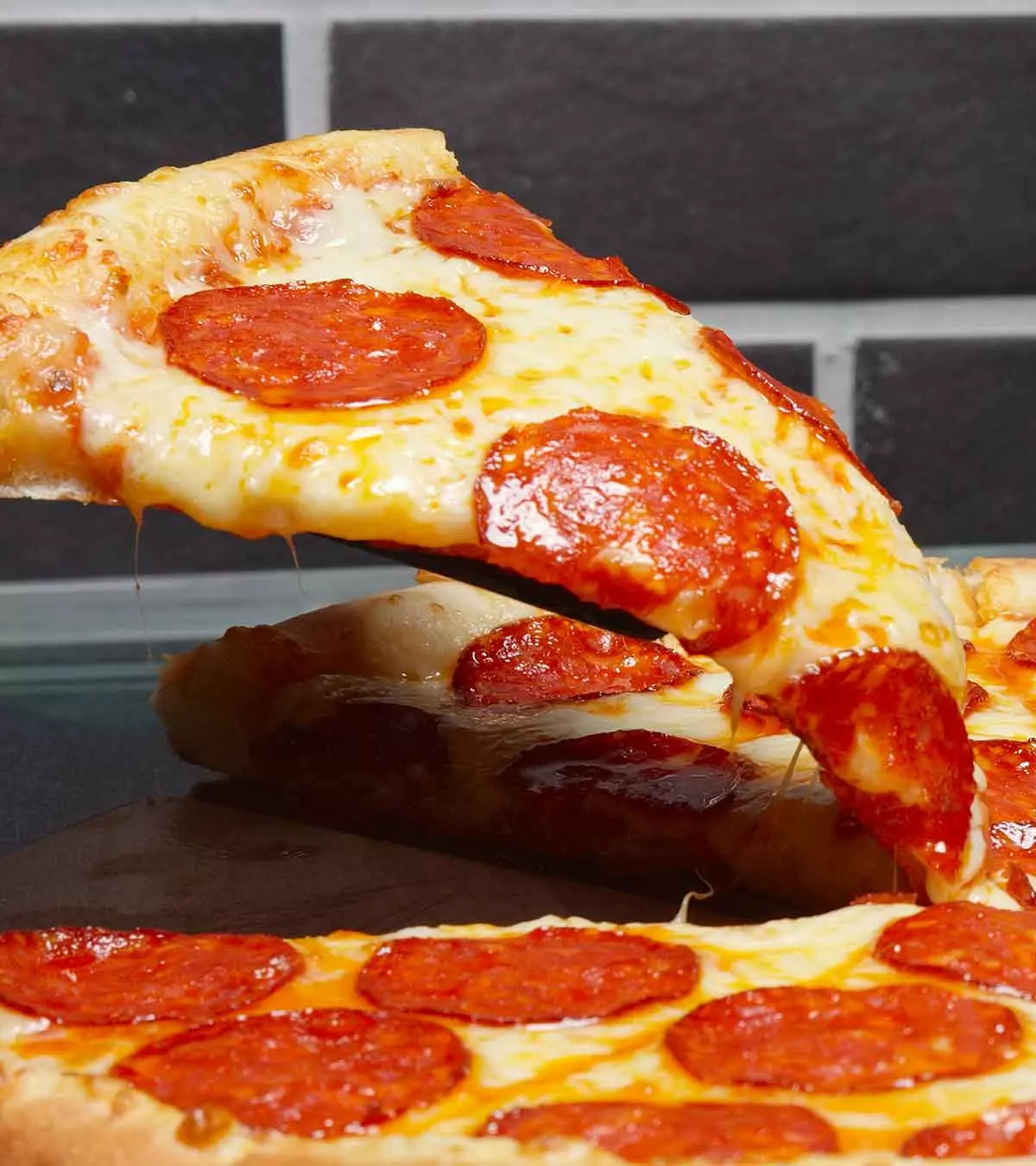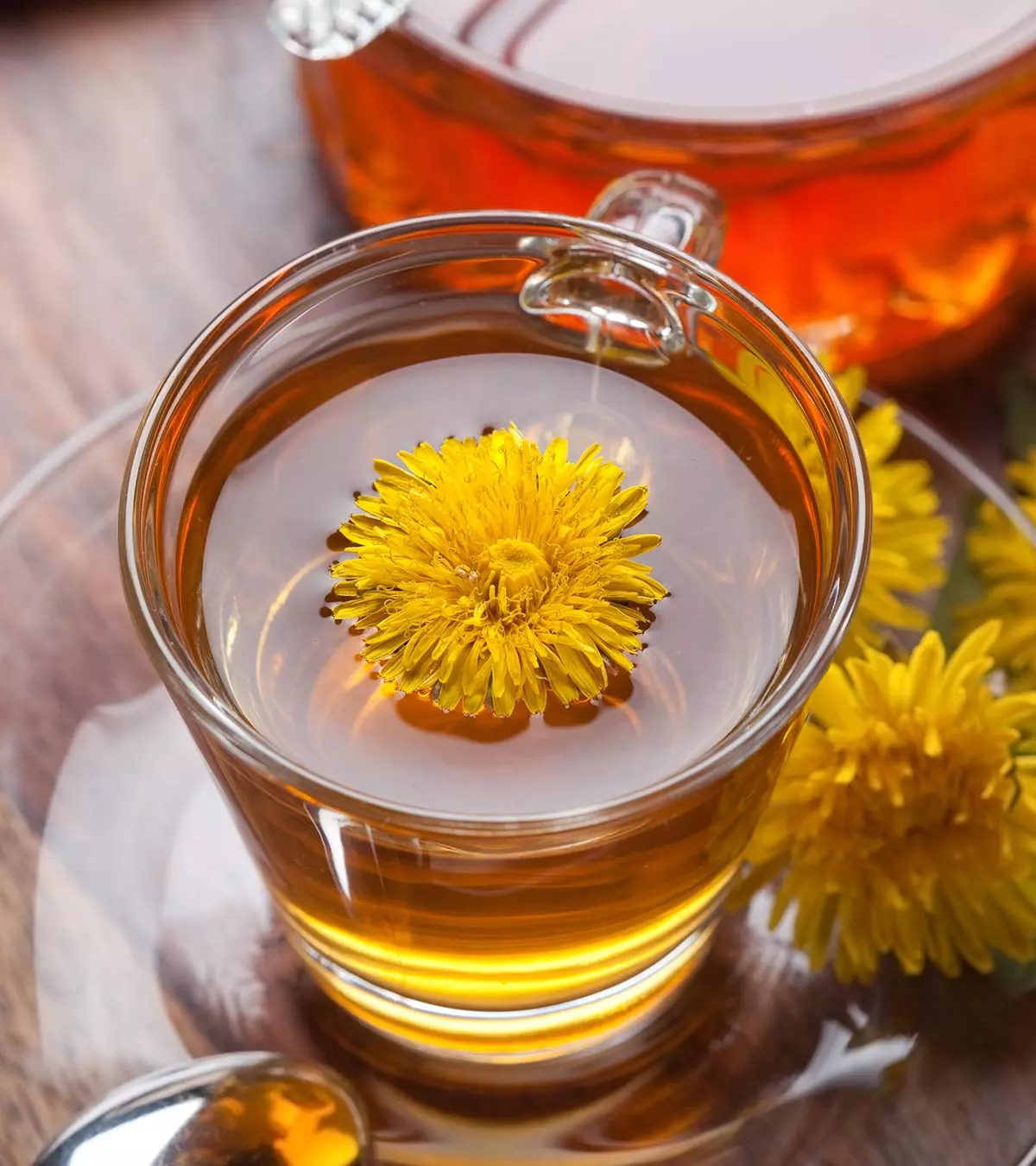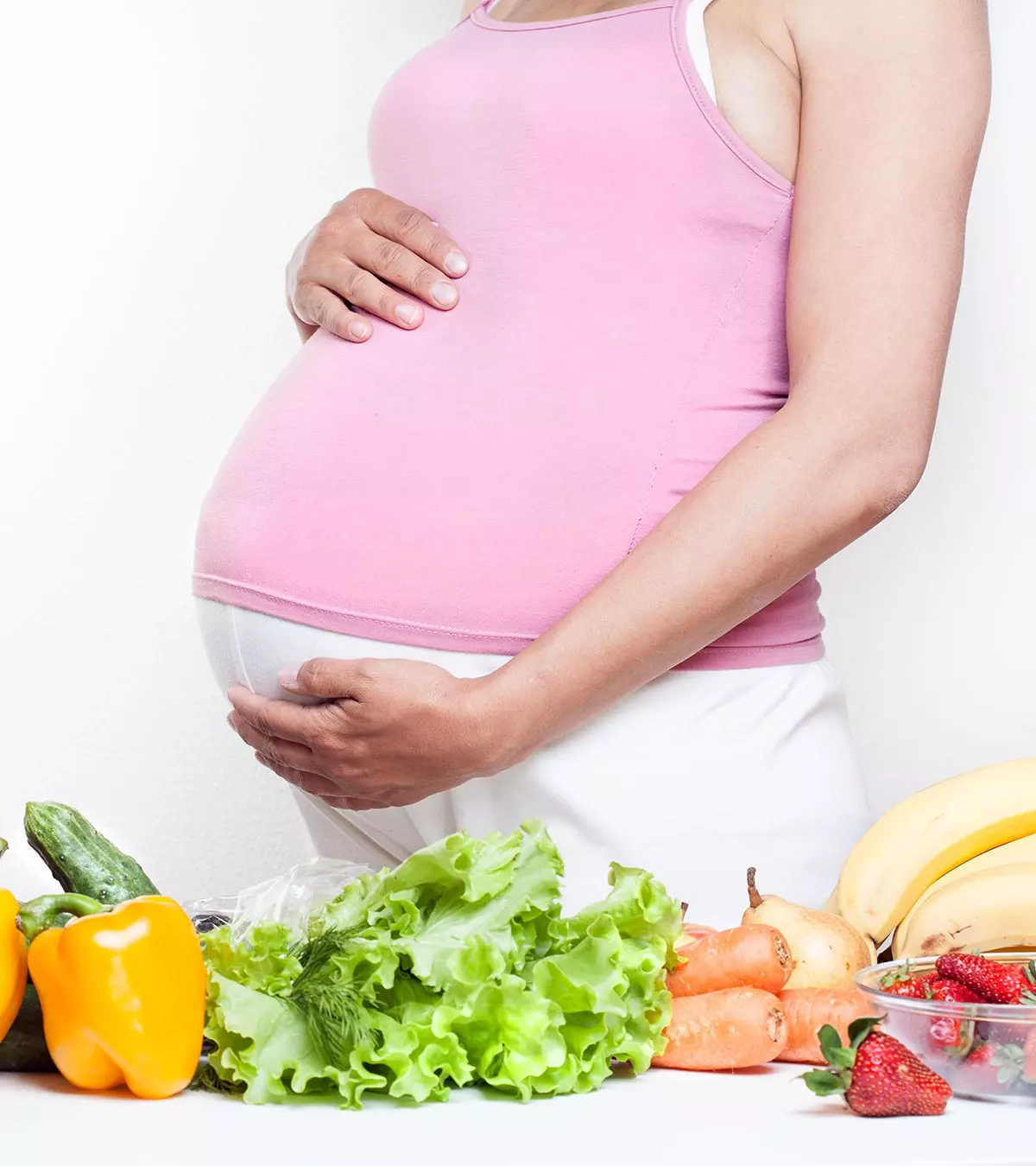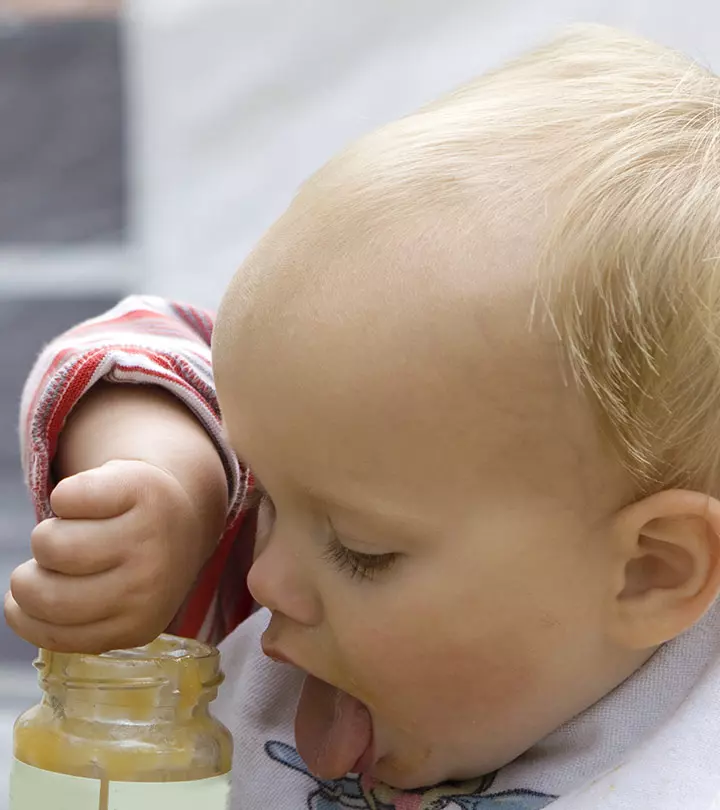
Image: ShutterStock
Every parent strives to provide a healthy, nourishing diet to their infants. Opting for nutritious food choices like butter for babies may provide sufficient calories and keep them interested in food. Also, babies need abundant food sources and sufficient nourishment to meet their daily energy requirements and support their growth and developmental processes. If your baby has started solid foods, you may plan to introduce some delicious yet power-packed foods like almond or peanut butter in their weaning food diet. Keep reading to understand the safety and benefits of introducing these naturally gluten-free kinds of butter for babies.

Key Pointers
- Peanut and almond butter are dairy-free and rich sources of essential proteins, fats, and other vital growth nutrients, making them suitable for babies beyond 18 months.
- To avoid adverse reactions, it is advisable to start with a small amount of nut-based butter and gradually increase the quantity.
- Introducing a limited amount of nut-based butter into a child’s weaning diet can provide sufficient nutrients and calories necessary for healthy development.
- Ensure to give smooth and good quality nut butter given to babies to avoid potential choking hazards from chunky or sticky butter.
- Parents should monitor their babies for allergic reactions or loose stools and seek medical advice if any intolerance symptoms occur.
Butter Power For Your Baby
Perhaps you are a vegan family, or you have dairy intolerance running in your family, and are worried that your baby might also have inherited it. For either reason, you are considering baby food like mashed banana or some soaked toast with some nut butter for a healthy punch. But wait; is it really good for your baby?
Yes, it is! But you do have to keep few things in mind, such as:
- Make sure your baby is not allergic to nuts.
- Do not go overboard; as these fatty butters can play havoc on the little one’s tummy.
The most popular non-dairy butters are peanut and almond butter, so let’s see how they can benefit your baby’s development.
Nutritional Value Of Peanut Butter And Almond Butter
Below is the nutritional value of 100g of peanut butter and almond butter, based on data from the FDA (1) (2).
| NUTRIENT | AMOUNT IN 100g OF CREAMY PEANUT BUTTER | AMOUNT IN 100g OF CREAMY ALMOND BUTTER |
|---|---|---|
| Energy | 562kcal | 645kcal |
| Protein | 21.9g | 20.8g |
| Total lipid (fat) | 46.9g | 53g |
| Carbohydrate | 25g | 21.2g |
| Total dietary fiber | 6.2g | 9.7g |
| Calcium | 0mg | 264mg |
| Magnesium | 0mg | 268mg |
| Potassium | 0mg | 745mg |
| Iron | 2.25mg | 4.11mg |
| Sodium | 438mg | 1mg |
| Vitamin B1(Thiamin) | 0mg | 0.095mg |
| Niacin | 0mg | 3.91mg |
| Biotin | 0mcg | 57.3mcg |
Source: U.S Department of Agriculture
Is “Peanut” Butter Good For Babies?
Peanut butter is a very popular nutrient-dense butter with a thick, creamy texture.
You may love this zinc-rich addition to your toast or porridge as a breakfast, but when it comes to giving it to your baby, there’s a lot of controversy involved.
- Some experts believe that it is best to give up the idea of introducing peanut butter to babies, while others believe it is safe to introduce it to them at an early age itself (3). The American Academy of Pediatrics (AAP) recommends giving peanut products, such as peanut butter, to babies between 4 and 6 months (12).
- According to the American College of Allergy, Asthma & Immunology (ACAAI), peanuts are one of the eight common foods that account for 90% of all allergic reactions (13). However, contrary to popular belief, a study found that regular consumption of peanut products from infancy to five years of age resulted in a 71% decreased risk of peanut allergy in teen years. It suggested a long-lasting protective effect from peanut allergy (14).
- However, if your baby is allergic to peanuts, introducing your already vulnerable baby to a spoonful of this plant-based food could turn out to be potentially dangerous. As the parent, you should make the best decision here.
 Quick fact
Quick factHow To Introduce Peanut Butter To Your Baby?
Unlike peanuts, which are a potential choking hazard for babies, peanut butter can be introduced to a baby at an early age. However, here are some things you should keep in mind:
- Due to peanut butter’s thick consistency, mixing one to two teaspoons of butter with two to three teaspoons of water is recommended to make the consistency thinner and more suitable for your baby (15).
- Administering thick lumps of peanut butter is not advisable as it might be a choking hazard for your baby.
- To help your baby adjust to the taste and texture, start with small amounts and gradually increase the quantity as they become more comfortable.
- You can also introduce peanut butter in powdered form in pureed baby food (16).
- Mixing peanut butter with expressed milk and freezing it in a silicone feeder to make popsicles is another way to introduce peanut butter to babies (16).
- After giving peanut butter to your little one, observing them for about ten to 15 minutes is advised to ensure there are no signs of any allergic reactions (4).
Is Almond Butter Safe For Babies?
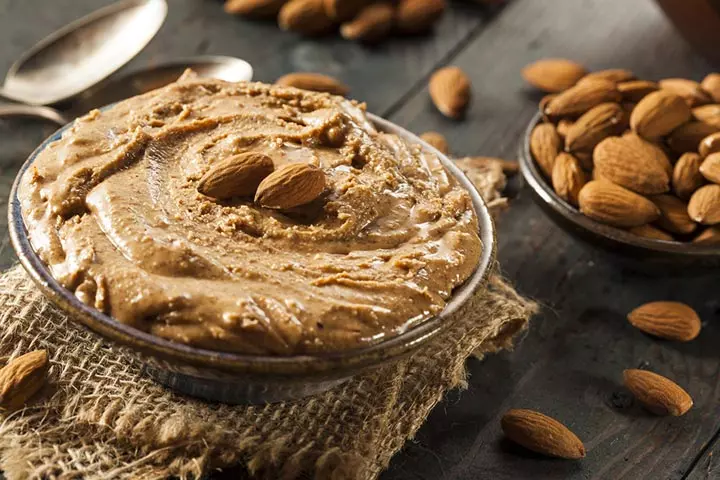
Almond butter has a texture and taste that is quite different from that of peanut butter. It is calcium-rich but not as thick as peanut butter, and may even contain certain bits of almonds in it.
- While almond butter is mineral-rich and does have many health benefits associated with its use, the chunky version may present a choking hazard to smaller babies who are just learning to consume solid food (5).
- Almond butter is vitamin-rich and a source of high protein and fats, both of which are needed by your baby, but is safe for consumption only if you or your spouse don’t have a history of almond allergies, and if the butter is smooth.
- In case you are not really aware of your baby’s sensitivity to particular nuts, offering him almond butter could trigger allergic reactions, which may turn out to be dangerous.
- You are therefore advised to be very careful while introducing almond butter during this age.
- You may give tree nut butter, like almond butter, to your baby mixed with pureed baby food, such as oatmeal or applesauce, if your baby has already been introduced to dairy products (17).
 Nutrition fact
Nutrition factWhen To Introduce These Butters To Your Baby?

It is important to first check if you have any history of peanut allergies yourself, or running somewhere in your or your spouse’s family. Only then should you introduce homemade baby food with these butters.
- Since these butters are sticky, and for many small infants, it may turn out to be a choking hazard, it is recommended that you introduce it to your child only after he crosses 18 months of age.
To ensure the baby doesn’t choke on peanut butter, Charisma, a mommy blogger, has a helpful approach. She says, “I do make sure that I don’t spread the peanut butter too thick, as that could gunk up the windpipe. I cut one-inch squares of toast for her. It is easier for her to eat and less messy since she isn’t squishing peanut butter in her fists. (i).” - Make sure you use good quality peanut butter from a reputed brand as only such butter is ideal for infant nutrition.
- Keep track of your baby’s bowel movements and digestion after you’ve introduced peanut butter to the baby for the first time, and if you do find something unusual, such as loose stools or diarrhea in babies, get them checked with your general practitioner.
Butter Recipes For Babies
Here are some baby-friendly recipes of peanut and almond butter(6):
1. Peanut butter puree

You will need:
- 2tsp peanut butter
- 2-3tbsp plain yogurt or pureed fruit or vegetable
How to prepare:
- Mix the peanut butter with yogurt or any vegetable or fruit puree for babies.
- Blend without any lumps
- Add more water for a thin consistency.
2. Almond butter pudding

You will need:
- 1 ripe banana
- 3tbsp Greek yogurt
- 1tbsp almond butter
- ¼tsp cinnamon
How to prepare:
- Blend all the ingredients until smooth.
- Transfer the mixture to your baby’s bowl and serve.
When To Stop Feeding Peanut/Almond Butter To Babies
If you suspect that your baby is allergic to peanuts and/or almonds, stop giving them these foods immediately. Some of the mild symptoms you may observe include (10) (13):
- Itchy bumps on the skin
- Vomiting
- Diarrhea
- Swelling in the face after eating peanut/almond products
In rare cases, a baby may also develop a severe allergic reaction, which may cause (10) (13):
- Difficulty in breathing
- Wheezing
- A strong cough
- Tongue swelling
- Throat tightness
- Becoming pale
- Loss of consciousness
If you suspect your baby has an allergy, it’s crucial to visit a doctor to get it checked and confirmed (10).
Frequently Asked Questions
1. Can I give butter to my baby?
Yes, adding a teaspoon of butter for every four ounces of food will help you add calories to your baby’s food (7).
2. Can I give my baby toast with butter?
When your child turns eight months and starts sitting up, you may offer them finger foods such as soft bread/toast with butter (8).
3. Are there any specific brands or types of almond and peanut butter that are recommended for babies?
When choosing almond or peanut butter for babies, it’s best to pick natural and unsweetened ones without added salt, preservatives, or extra ingredients. Always read the label and talk to a doctor for recommendations for specific brands.
4. How much almond and peanut butter should be given to babies?
The amount of almond or peanut butter to give to babies depends on how old they are and what their specific needs are. It’s usually best to start with a small amount of peanut butter diluted in water or breastmilk. Offer about a teaspoon, and see how they handle it. You should also keep an eye out for any signs of allergies. It’s always a good idea to talk to a doctor for advice that fits your baby’s situation (4).
5. Are there any alternatives to almond and peanut butter for babies?
Yes, there are other options besides almond and peanut butter for babies. You can try butter made from cashews, pecans, hazelnuts, or sunflower seeds. Remember to be mindful of potential allergies and seek advice from a pediatrician to find the best alternatives for your baby.
6. When to introduce peanut butter to a baby with eczema?
For babies with severe eczema or existing food allergies, it’s recommended to introduce solid foods, including peanut butter, around 6 months of age, but not before 4 months. This advice is based on guidelines for infant feeding and allergy prevention from the Australian Society of Clinical Immunology and Allergy (ASCIA) (9).
7. How to make almond butter for babies?
To make almond butter for babies, grind roasted almonds in a blender until it becomes smooth and creamy. You can add a small amount of oil or water to make it smoother, but it’s not mandatory.
Do you have any particular healthy eating recipes for wholesome food items that use nut butters and work out wonderfully for children? Do share them in the comments box below.
Infographic: Precautions For Serving Almond & Peanut Butter To Babies
Peanut and almond butter can be a good choice if you’re looking for a dairy-free alternative. The following infographic includes some safety tips and precautions you must consider when feeding these butter types to the baby.
Some thing wrong with infographic shortcode. please verify shortcode syntaxIllustration: Almond & Peanut Butter For Babies: Safe Use And Benefits
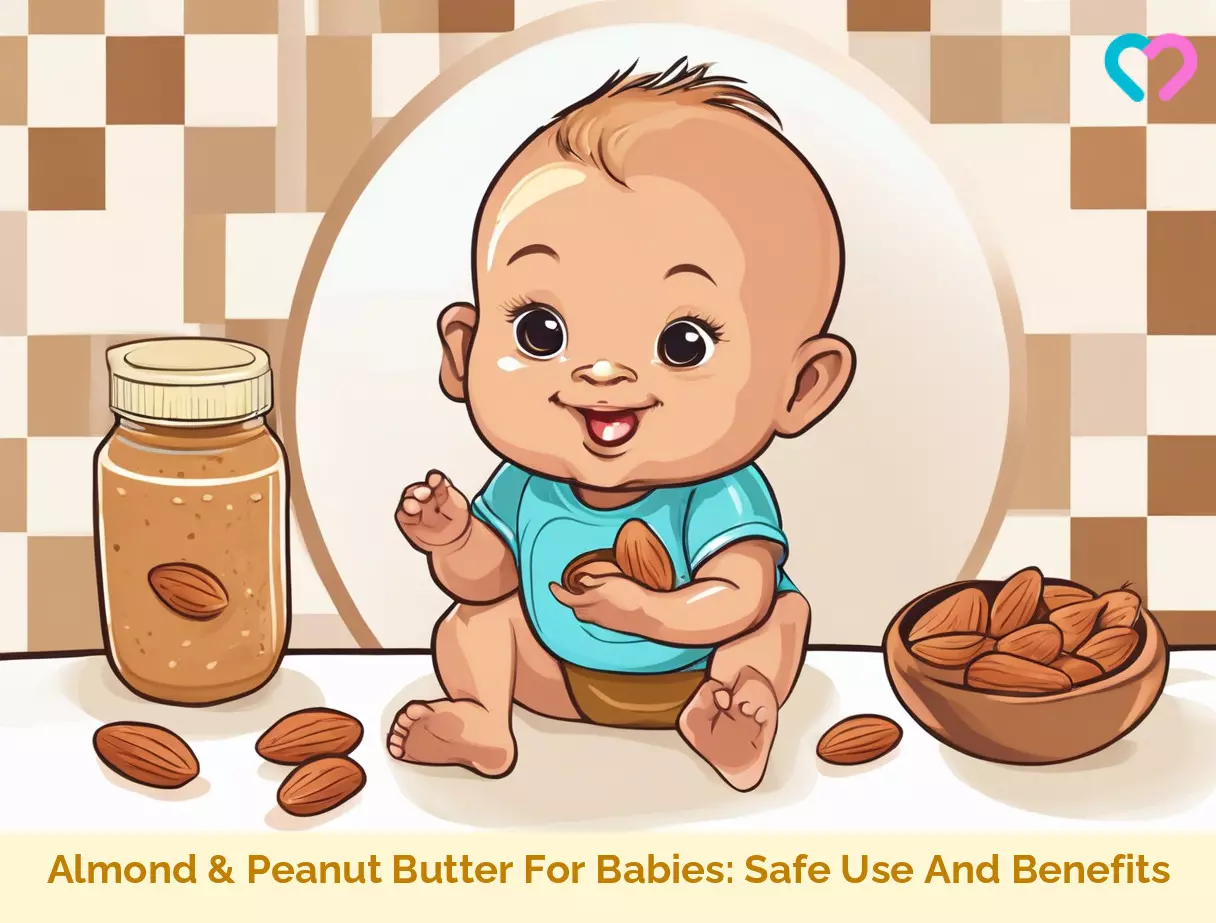
Image: Stable Diffusion/MomJunction Design Team
Personal Experience: Source
MomJunction articles include first-hand experiences to provide you with better insights through real-life narratives. Here are the sources of personal accounts referenced in this article.
i. Peanut butter toast.https://baby-led-solids.blogspot.com/2010/11/peanut-butter-toast.html
References
- Creamy Peanut Butter
https://fdc.nal.usda.gov/food-details/1860555/nutrients - Almond butter, creamy
https://fdc.nal.usda.gov/food-details/2262074/nutrients - New guidelines detail use of ‘infant-safe’ peanut to prevent allergy.
https://publications.aap.org/aapnews/news/12250/New-guidelines-detail-use-of-infant-safe-peanut-to?autologincheck=redirected - Prevent peanut allergies with … peanut puff.
https://utswmed.org/medblog/exposure-peanut-allergies/ - Choking Prevention
https://www.healthychildren.org/English/health-issues/injuries-emergencies/Pages/Choking-Prevention.aspx - Introducing Peanut Products to Your Baby
https://www.massgeneral.org/children/food-allergies/introducing-peanut-products-to-your-baby - Adding Calories into Your Baby’s Food.
https://www.ucsfbenioffchildrens.org/education/adding-calories-into-your-babys-food - Starting Baby on Solid Food.
https://www.longwoodpeds.com/patient-education/nutrition/starting-baby-solid-food - ASCIA Guide for introduction of peanut to infants with severe eczema and/or food allergy.
https://www.allergy.org.au/hp/papers/ascia-guide-peanut-introduction - Peanut and tree nut allergy.
https://www.rch.org.au/kidsinfo/fact_sheets/Peanut_and_tree_nut_allergy/ - Almonds
https://nutritionsource.hsph.harvard.edu/food-features/almonds/ - Peanut Allergy: What to Know About the Latest Prevention Guidelines.
http://healthychildren.org/English/health-issues/conditions/allergies-asthma/Pages/Peanut-Allergies-What-You-Should-Know-About-the-Latest-Research.aspx - Food Allergy.
https://acaai.org/allergies/allergic-conditions/food/ - Introducing peanut in infancy prevents peanut allergy into adolescence.
https://www.nih.gov/news-events/news-releases/introducing-peanut-infancy-prevents-peanut-allergy-into-adolescence - Alkis Togias et al.; (2017); Addendum guidelines for the prevention of peanut allergy in the United States: Report of the National Institute of Allergy and Infectious Diseases–sponsored expert panel.
https://www.jacionline.org/article/S0091-6749(16)31222-2/pdf - Recipe Video: 8 Ways to Introduce Peanuts Early.
https://nationalpeanutboard.org/news/how-to-feed-peanut-butter-to-baby-8-ways-to-introduce-peanuts-early/ - Baby-Led Weaning.
https://www.sd.gov/wic?id=kb_article_view&sysparm_article=KB0041184&sys_kb_id=b0ebb3df47e90a10a497127ba26d435a&spa=1
Community Experiences
Join the conversation and become a part of our nurturing community! Share your stories, experiences, and insights to connect with fellow parents.
Read full bio of Dr. Joel Warsh
Read full bio of Jessica Albert
Read full bio of Swati Patwal
Read full bio of Vidya Tadapatri






